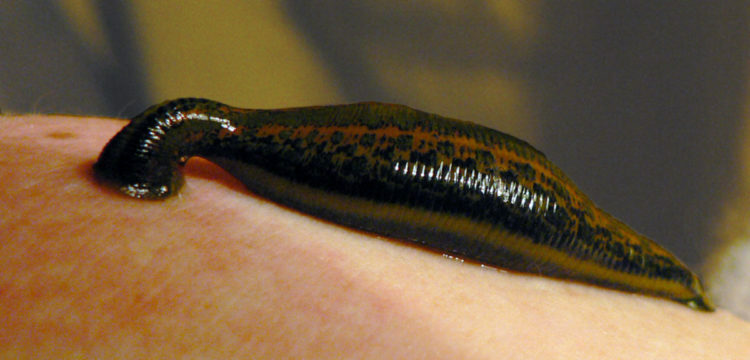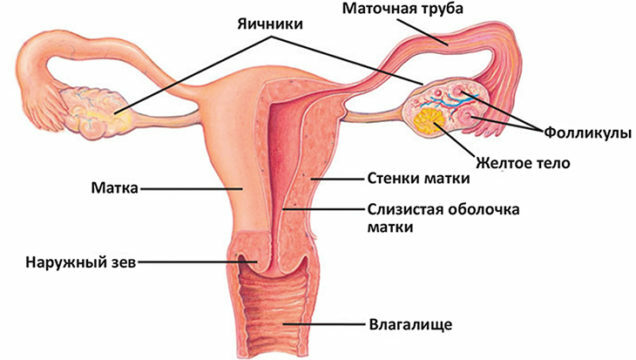Ovarian teratoma is a neoplasm that consists of embryonic tissues. Most often, a teratoma is a benign tumor, the occurrence of which is not accompanied by specific symptoms. In the medical literature, the teratoma has many names: dermoid cyst, monodermoma, tridermoma, teratogenic formation. The dermoid cyst is a capsule made of elastic tissue, inside of which hair, nails and skin integrate. The peculiar cyst has a leg, by means of which it is attached to the ovary.
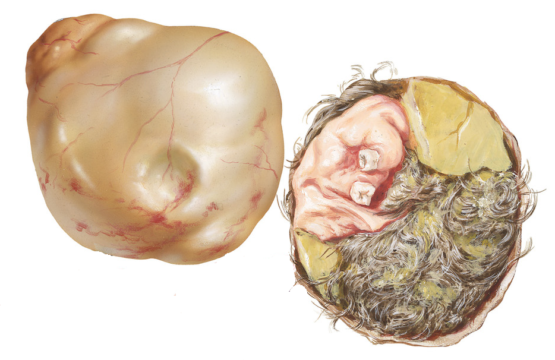
Causes of the appearance of
Until now, doctors can not determine the exact cause of the occurrence of teratoma of the ovary, but all of them are inclined to the version that a predisposition to this kind of cyst arises at an embryonic level. To diagnose the tumor at the initial stage is very difficult, because the woman is not bothered by any symptoms.
The causes of the appearance of monodermoma are usually the following:
- A sharp change in the hormonal background of a woman;
- The initial and final stage of the menstrual cycle;
- The impact of some contraceptives;
- Operative intervention in female genital organs;
- Age after 35 years.
Types of teratoma of the ovary
Teratogenic formation can be of two types:
- Immature ovarian teratoma is not rarely taken for a malignant tumor, although it is only its predecessor. Immature teratoma develops very quickly, and passes into an oncological neoplasm. At the time of diagnosis of the tumor, it is difficult to understand the contents of the capsule. As a rule, only with surgical intervention you can find out the contents of the teratoma. When this type of teratoma appears, the woman feels the following symptoms:
- Weakness, fatigue;
- Sharp weight loss;
- The menstrual cycle is already in a failed form.
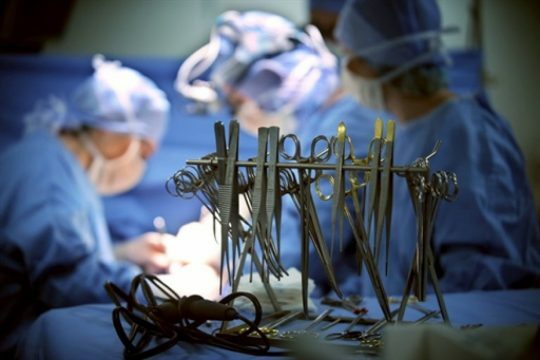
With early detection of an immature teratoma, the chance of a full recovery is quite high. In neglected form, the teratoma is transformed into a malignant tumor, the treatment of which involves surgical intervention.
- Mature teratoma of the ovary differs from the immature appearance and character of the filling. It consists of embryonic tissues and is almost always a benign entity. In turn, this kind of teratoma is divided into the following types:
- Cystic neoplasm has a smooth surface, under which there is a turbid liquid. In the cystic tumor, you can find cartilage, teeth, hair. Cystic teratoma is almost always a benign formation, which rarely turns into a category of cancer. In size, the dermoid cyst can reach up to 10 centimeters. The inconvenience of a cystic tumor begins to cause a twisting of the legs. Treatment of a tumor can only be prompt, even pregnant women are no exception.
- A solid tumor is not a uniform formation, it consists of small cystic vesicles. The surface of the formation can be smooth or bumpy, and dense to the touch. Inside the cyst is a viscous mucus of an unknown origin.
Location of the dermoid cyst
Ovarian cyst develops unilaterally, in rare cases, doctors diagnose its location simultaneously in two ovaries. According to statistics, the right ovary is more susceptible to various kinds of diseases, and teratomas as well. This phenomenon can be explained by the following versions:
- , the right side of the abdominal cavity is provided with a stronger blood supply than the left one;
- right ovary larger than the left;
- the right ovary is located next to the appendix, the inflammation of which can provoke the appearance of a cyst.
Sometimes a teratoma of the right ovary can cause inflammation of the appendix, since they are located close to each other. Conversely, a large cyst on the right ovary can make it difficult to diagnose the "blind" gut.
According to statistics, the teratoma of the left ovary is much less common. Doctors explain this by the reduced functionality of the left ovary. Nature has created a female reproductive system in such a way that ovulation often passes right to the ovary, and not to the left. It turns out that the left ovary undergoes a lesser load and therefore there are less often tumor processes in it.
Symptoms of the disease proceed in the same way, regardless of whether the dermoid cyst is located in the right or left ovary.
Symptoms of
The insidiousness of the teratoma of the ovary lies in the fact that it does not give the woman no worries until it reaches a large size. If a woman begins to feel certain inconveniences, this means that the tumor in the ovary has reached a size exceeding 7-8 centimeters. In this case, neighboring organs begin to shift to the side and there are first inconveniences associated with the appearance of the cyst. The main signs of the emerging teratoma are:
- Gravity in the lower abdomen;
- Frequent urge to urinate;
- Defecation abnormalities( constipation or diarrhea);
- In rare cases, decreased hemoglobin;
- The lower abdomen becomes swollen.
The first signals of the teratoma are given at the onset of the inflammatory process - a woman's body temperature rises, pulsating pain sensations appear in the lower abdomen.
Diagnosis
If you consider that there is no inconvenience to the dermoid cyst, it is found, as a rule, on a routine examination or when registered with a pregnant woman. Having revealed the neoplasm on examination, the gynecologist directs the woman to the following types of examination:
- Examination with the help of palpation and mirrors;
- ultrasound of the abdominal cavity and pelvic organs;
- Radiography;
- Doppler;
- Biopsy of tumor tissues to determine the nature of the disease with the help of oncomarker;
- Computed tomography;
- General and biochemical blood test.
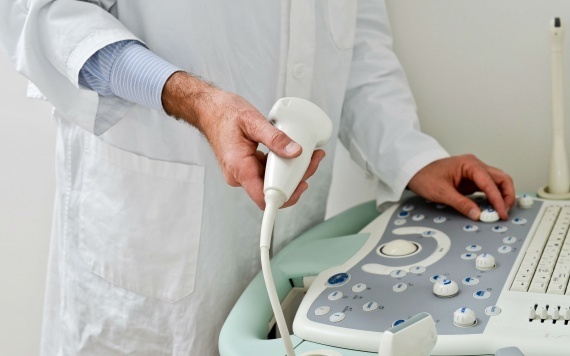
The most common type of examination is ultrasound. The doctor directs it to him at any suspicion of the presence of a tumor process. Due to ultrasound examination, it is possible to determine the exact size of the cyst, its shape, the thickness of its walls, the length of the stem. A biopsy allows one to say with accuracy whether a malignant or benign tumor. Only after a complete laboratory and instrumental examination the doctor prescribes further treatment.
Treatment
Based on the diagnostic results obtained, the doctor prescribes a method for treating the teratoma. The method of therapy depends on many indicators: the size and type of the cyst, its morphological structure. The following factors are also taken into account:
- The neglect of the tumor process;
- Age of the patient;
- Presence of chronic diseases;
- Immune system status;
- If the cyst is recognized as an oncological disease, sensitivity to chemotherapy is determined.
Depending on the type of diagnosed cyst( benign or malignant), the treatment of teratoma is carried out together with hormonal or antitumor therapy.
Benign teratoma
Treatment of mature teratoma is performed only surgically. The earlier the cyst is detected and removed, the less likely the occurrence of oncological formations. With a small cyst size, laparoscopy is used, which allows to get rid of teratoma with the least damage to the body. Partial removal of the ovary along with the cyst is practiced in young women planning to have children in the future. Patients in the menopause period remove the ovary completely, in order to reduce the likelihood of overgrowing the cyst into a malignant tumor. According to statistics, surgery to remove dermoid cysts has a favorable outcome and rarely leads to complications. In the postoperative period, no special treatment is required, the body gradually restores full working capacity.
Immature tumor or malignant formation of
Immature tumor is treated not only surgically, a woman is also prescribed chemotherapy and radiation. Despite the fact that teratomas are not always sensitive to chemotherapy, when doctors detect oncological education, doctors use all available methods to obtain a positive result. Unfortunately, the treatment of an immature teratoma does not always bring the desired result. According to statistics, even malignant formation on the ovary, found at an early stage, provokes metastasis in many vital organs, which leads to a fatal outcome.

Methods for the removal of teratoma
Most of the removal of the ovarian cyst is performed by laparoscopy. An optical device is inserted into the abdominal cavity through a small incision allowing the tumor to be removed with minimal damage to the body. The recovery period after such an operation is reduced to one week. Before laparoscopy, the patient must pass the following tests:
- General and biochemical blood test, including for oncomarkers;
- Detection of blood type and Rh factor;
- Analyzes for venereal diseases and HIV;
- If you find any accompanying pathologies, you need to consult outside experts.
Laparoscopy is performed under general anesthesia and has a number of advantages: rapid recovery of the body, lack of large seams, small blood loss, the possibility of discharge from the hospital a few days after the operation.
Just a few decades ago, teratoma was removed only surgically. The operation lasted about two hours, after which, a woman should adhere to a sparing regimen. Currently, a canal operation is used if the cyst has reached an alarming size, the inflammatory process has begun. Restoration of the body is slower, in the first days after surgery, the seams cause some inconvenience.
Teratoma occurs on the ovaries for various reasons and has several varieties. As a result of the diagnosis, the nature of the neoplasm is revealed and further treatment is planned. If the cyst belongs to the category of oncological tumors, radiation treatment and chemotherapy are added to surgical treatment. Benign teratomas also require complete removal. Depending on the size of the dermoid cyst and the area of the affected ovary, a decision is made to completely or partially remove the organ. The sooner a teratoma is detected, the more likely a favorable outcome is.


